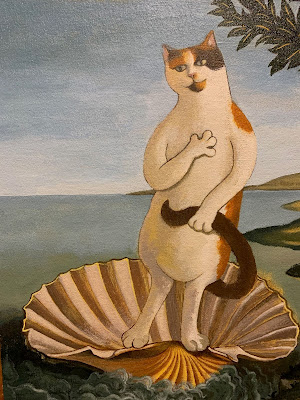Here is the process of my painting of my cat in the style of a Byzantine icon. It was executed in acrylic paint on a gessoed hardboard panel:
I decided to repaint the background with a heavy body acrylic white(I used LUKAS Pastos) with a little yellow mixed in. I used a synthetic bristle brush so that this new ground layer would have a relief to it in preparation for the transparent layers that would go on later.
Since I would be painting the details on the clothing thinly with transparent colors, I also re-grounded the clothing area with a soft body acrylic white tinted with a touch of burnt umber.

When the ground colors were dry, I applied two thin layers of Transparent Raw Sienna over the background. I used acrylic glazing medium to thin down the colors; using water would have dulled the color and created a weak paint film. The glazing medium retained the luminosity and sheen of the layers, giving it a richness much like the oil glazes used in old icon paintings.
I also added some modeling and detail to the figure.
I began painting in the folds of the fabric in transparent layers of raw sienna mixed with burnt umber. Using liner brushes helped with the long lines.
More articulation of the fabric. I used some of the white/burnt umber tint of the clothing ground to re-cut the shape of the left sleeve opening.
I painted over the whole background with Burnt Umber mixed with a slow drying glazing medium. While the mixture was still wet, I removed most of the dark layer with a paper towel. The dark paint stayed in the valleys of the textured paint which emphasized the relief. I wanted the painting to look old, so I used this technique which is often used in antiquing furniture and movie props. Rembrandt used it a lot as well for his textural effects.































